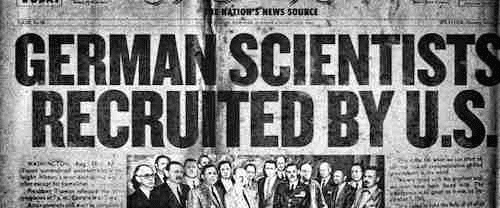The new Indiana Jones movie, Indiana Jones and the Dial of Destiny, shares much in common with the first movie in the series — Raiders of the Lost Ark. Among the common features is that the villain in the new movie, as in Raiders, is a German Nazi.
How is that? While Raiders was set when the National Socialists ruled Germany, the new movie takes place roughly 30 years later. The twist is that in the new movie the German Nazi villain, a physicist, had moved to America toward the end of or after World War II and, under an assumed name, played a celebrated role in the advancement of the American space program.
The means of this trajectory for the villain is not explained in the new movie. But, it is a trajectory that is quite similar to that of other German scientists after World Wat II that was facilitated by a United States government’s Project Paperclip.
Project Paperclip brough many German scientist to America, including some whose pasts would have made them subjectable to war crime prosecution. While US officials proclaimed the need to achieve justice in the Nuremberg Trials, allowances were made so scientists who could advance US technology for military and other purposes could be brought out of Europe, including secretly, and set up with new lives in America.
A key expertise sought in Project Paperclip scientists was in rocket science, important for military missiles development and the American space program. In a March 31 article at the website of the Smithsonian Air and Space Museum, Michael Neufeld wrote about Project Paperclip bringing rocket scientists to America. He dedicates a paragraph of his article to discussing a well-known and influential individual among these scientists — Wernher von Braun. Neufeld wrote:
A case in point was the V-2 ballistic missile group led by Dr. Wernher von Braun. He had been a party member and SS officer and was at least tangentially involved in the murderous exploitation of concentration-camp prisoners in missile production, as were several associates. The U.S. Army kept that information classified and brought von Braun and about 125 colleagues to Fort Bliss, outside El Paso, Texas. The Germans helped Americans launch V-2s and were tasked with developing an experimental cruise missile. In 1950, von Braun’s group was moved to Redstone Arsenal in Huntsville, Alabama, and became the heart of the Army’s nuclear-armed ballistic missile development. In his spare time, von Braun made himself world-famous by advocating spaceflight in magazines and on TV. Soon after the Soviets launched Sputnik in October 1957, he and his German-led group, now numbering in the thousands (almost all native-born Americans), helped launch the first United States satellite, Explorer I. In 1960, von Braun’s division of the Army Ballistic Missile Agency was transferred to a new civilian space agency, NASA. The Huntsville Germans, most naturalized in 1954-1955, went on to lead the development of the Saturn rockets that put Americans on the Moon in 1969.
Like von Braun, the villain in Indiana Jones and the Dial of Destiny lived in Alabama and played a prominent role as a scientist advancing the US space program. He is depicted in the movie being interviewed in his New York City hotel room the day of a parade in the city celebrating a NASA manned space mission. It is also revealed that he was scheduled to meet with the president of the United States soon thereafter. The parallels between the real and fictional scientists are strong.
Indiana Jones and the Dial of Destiny is an entertaining movie. By featuring as the villain a man with similarities to Wernher von Braun, the movie may also play an important educational role, leading people to learn more about Project Paperclip and to consider its implications in regard to the US government.


